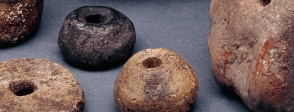Show the image of spinning and weaving tools on the whiteboard. Ask students what they think the objects are for. The weights are too big and not pretty enough to be beads; the combs are too narrow to be used on hair. Explain what each object is for and use the spinning and loom videos in For the classroom to show the students how the spindles, loom weights and combs were used. Discuss why the yarn, loom and finished cloth have not survived and look at the traces of cloth found at Burton Flemming in For the classroom to discuss ways in which we are able to learn about it.
Download the image bank People of Iron Age Britain from the British Museum website. It is accompanied by notes for teachers with a wide range of activities for the classroom
Here are two broader enquiries.
How important was appearance in the Iron Age?
Use the objects in A bigger picture to discuss what they tell us about how people dressed and looked. Encourage students to think about how some of the objects were worn. Do these objects suggest that appearance was important? Do the students think that everyone owned objects such as these? Discuss what effect personal appearance might have in Iron Age society.
What was the pace of life in the Iron Age?
Do some simple weaving with the students either using paper or plastic strips, raffia or yarns. Consider how long it takes them to make a small piece and then think about how long it would take to weave enough cloth for a whole garment using much finer thread. Who do they think probably did the spinning and weaving in the Iron Age? When would all that work have to be done without lighting? How often would people get new clothes? So what would happen if clothes were damaged or wore thin? Encourage the students to reflect on the differences between then and now and how the pace of life has changed.
These tools provide a good opportunity for doing some hands-on work to explore clothmaking.
Try some aspects of the hand manufacture of cloth such as spinning, dyeing the yarn, weaving and sewing. Students can make spindles using wooden dowel and air-drying clay. Buy some washed fleece to spin with. Try vegetable dyes to see what colours you get. Try weaving on card, or braiding or using a lucet – a two-pronged weaving comb. Sew pieces of braided or woven fabric together to make a class textile. The principle of weaving can also be demonstrated using paper strips.
Bring in a selection of different modern fabrics to explore. Help students to identify each one and explore how they were made. Give the students magnifying glasses so they can see the weave of threads. Which are made from natural yarns and which are made from synthetic materials? It can be fascinating for students to pick cloth apart to see how multiple coloured threads are woven together. Students could devise experiments to test the qualities of these fabrics, for example, warmth, strength, comfort, washability.


